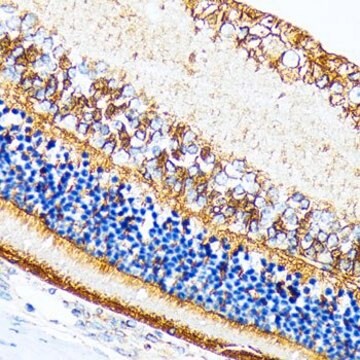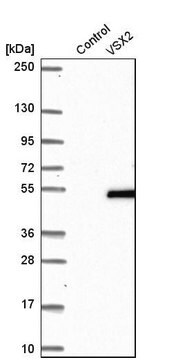一般說明
We are committed to bringing you greener alternative products, which adhere to one or more of The 12 Principles of Green Chemistry.This antibody is Preservative-free, produced without the harm or sacrifice of animals and exceptionally stable to allow for ambient shipping and storage if needed and thus aligns with "Waste Prevention", "Designing Safer Chemicals" and "Design for Energy Efficiency".
Click here for more information.
ZooMAb® antibodies represent an entirely new generation of recombinant monoclonal antibodies.
Each ZooMAb® antibody is manufactured using our proprietary recombinant expression system, purified to homogeneity, and precisely dispensed to produce robust and highly reproducible lot-to-lot consistency. Only top-performing clones are released for use by researchers. Each antibody is validated for high specificity and affinity across multiple applications, including its most commonly used application. ZooMAb® antibodies are reliably available and ready to ship when you need them.
特異性
Clone 2F8 is a ZooMAb® Rabbit recombinant monoclonal antibody that specifically detects Retinal pigment epithelium-specific 65 kDa protein (RPE65). It targets an epitope within 20 amino acids from the C-terminal half.
免疫原
KLH-conjugated linear peptide corresponding to 20 amino acids from the C-terminal half of human Retinal pigment epithelium-specific 65 kDa protein (RPE65).
應用
Quality Control Testing
Evaluated by Western Blotting in Mouse Retina tissue lysate.
Western Blotting Analysis: A 1:1,000 dilution of this antibody detected RPE65 in Mouse Retina tissue lysate.
Tested applications
Western Blotting Analysis: A 1:1,000 dilution from a representative lot detected RPE65 in Rabbit and human Retina tissue lysates.
Immunofluorescence Analysis: A 1:1,000 dilution from a representative lot detected RPE65 in human retina tissue sections.
Immunohistochemistry (Paraffin) Analysis: A 1:1,000 dilution from a representative lot detected RPE65 in human retina tissue sections.
Affinity Binding Assay: A representative lot of this antibody bound Retinal pigment epithelium-specific 65 kDa protein (RPE65) peptide with a KD of 3.1 x 10-7 in an affinity binding assay.
Note: Actual optimal working dilutions must be determined by end user as specimens, and experimental conditions may vary with the end user
標靶描述
Retinoid isomerohydrolase (UniProt: Q16518; also known as EC:3.1.1.64, All-trans-retinyl-palmitate hydrolase, Lutein isomerase, Meso-zeaxanthin isomerase, Retinal pigment epithelium-specific 65 kDa protein, Retinol isomerase) is encoded by the RPE65 gene (Gene ID: 6121) in human. Retinol isomerase is a lipid-anchor protein that is attached to the membrane when palmitoylated and is present in soluble form when unpalmitoylated. It is shown to be critical for retinoid cycle and is involved in regeneration of 11-cis-retinal, the chromophore of rod and cone opsins. It catalyzes the cleavage and isomerization of all-trans-retinyl fatty acid esters to 11-cis-retinol that is further oxidized by 11-cis retinol dehydrogenase to 11-cis-retinal for use as visual chromophore. It can also catalyze the isomerization of lutein to meso-zeaxanthin an eye-specific carotenoid. The soluble form is reported to binds vitamin A (all-trans-retinol), making it available for lecithin retinol acyltransferase (LRAT) processing to all-trans-retinyl ester. The membrane form, palmitoylated by LRAT, binds all-trans-retinyl esters, making them available for isomerohydrolase processing to all-cis-retinol. The soluble form can be regenerated by transferring its palmitoyl groups onto 11-cis-retinol, a reaction catalyzed by LRAT. It undergoes light-dependent intracellular transport to become more concentrated in the central region of the retina pigment epithelium cells. Mutations in RPE65 gene are known to cause Retinitis pigmentosa that is characterized by retinal pigment deposits visible on fundus examination and primary loss of rod photoreceptor cells followed by secondary loss of cone photoreceptors. This ZooMAb® recombinant monoclonal antibody, generated by our propriety technology, offers significantly enhanced specificity, affinity, reproducibility, and stability over conventional monoclonals.
外觀
Purified recombinant rabbit monoclonal antibody IgG, lyophilized in PBS, 5% Trehalose, normal appearance a coarse or translucent resin. The PBS/trehalose components in the ZooMAb formulation can have the appearance of a semi-solid (bead like gel) after lyophilization. This is a normal phenomenon. Please follow the recommended reconstitution procedure in the data sheet to dissolve the semi-solid, bead-like, gel-appearing material. The resulting antibody solution is completely stable and functional as proven by full functional testing. Contains no biocide or preservatives, such as azide, or any animal by-products. Larger pack sizes provided as multiples of 25 μL.
重構
300 μg/mL after reconstitution at 25 μL per vial. Please refer to guidance on suggested starting dilutions and/or titers per application and sample type.
儲存和穩定性
Recommend storage of lyophilized product at 2-8°C; Before reconstitution, micro-centrifuge vials briefly to spin down material to bottom of the vial; Reconstitute each vial by adding 25 μL of filtered lab grade water or PBS; Reconstituted antibodies can be stored at 2-8°C, or -20°C for long term storage. Avoid repeated freeze-thaws.
法律資訊
ZooMAb is a registered trademark of Merck KGaA, Darmstadt, Germany
免責聲明
Unless otherwise stated in our catalog or other company documentation accompanying the product(s), our products are intended for research use only and are not to be used for any other purpose, which includes but is not limited to, unauthorized commercial uses, in vitro diagnostic uses, ex vivo or in vivo therapeutic uses or any type of consumption or application to humans or animals.




